
Photo by Sophia Kramer
Paper & Parchment Repair
Books, pamphlets, maps, broadsides, dust jackets, ephemera, documents, and more---these items printed or written on paper and parchment may suffer through use or age or inherent flaws: tears, tattering, and losses; curling or creases; insect and mold damage; split folds. Most problems but not all can be addressed—the deterioration of brittle paper, for example, cannot be stopped, but it can be slowed and stabilized.
We can assess the condition of these items and provide options for repairing their damage and stabilizing their vulnerabilities, thus ensuring their preservation for future generations.
This original dust jacket was tattered and torn, and some large pieces had detached. Someone had previously repaired it from the back with masking tape, transparent tape, and a piece of paper, and had even colored in skinned areas on the front with crayon, as well as coloring the masking tape so it would blend in. We removed the tape and other old repair material and backed the damaged areas with Japanese paper and wheat starch paste, which allowed us to realign the torn edges and replace the detached pieces. We then removed as much of the crayon as possible with heat and blotter, and covered the skinned areas with Japanese paper in tones that harmonized with the surrounding areas.
Dust Jacket
This fragment of a parchment indenture was torn and had several areas of loss. We stabilized the tears and infilled the losses with layers of toned parchment and Japanese paper, adhered with fish glue.
Parchment Indenture
A botany classroom poster from early 20th-century China was badly eaten by insects while in storage. We stabilized it from behind with a mid-weight Japanese paper in a similar tone to the original poster, and adhered it with wheat starch paste.
Insect Damage
Also from early 20th-century China, this set of twelve slim books is housed in its original slipcase, but over the years, the edges of the slipcase had split apart. We repaired it by inserting strong, thin Japanese paper underneath the original covering paper with wheat starch paste.
Broken Slipcase
Parchment-covered clamshell box
A large box covered in parchment fell prey to a hungry dog, which chewed away one corner of the spine and left tooth marks along the bottom edge. We trimmed away the chewed edges, rebuilt the front corner and spine with layers of heavy paper, and re-covered the damaged areas of the case and tray wall with new parchment in a similar tone to the original. We also stabilized the loose bits around the tooth marks.
Notes from the Bench
Stories, updates, and notable projects

























